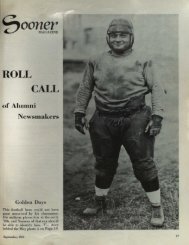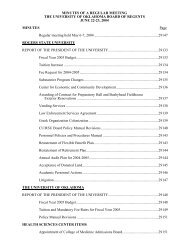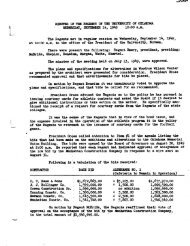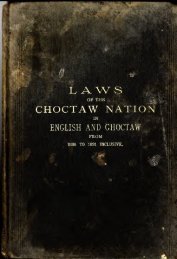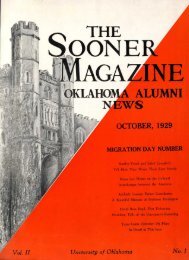View Article - University of Oklahoma
View Article - University of Oklahoma
View Article - University of Oklahoma
Create successful ePaper yourself
Turn your PDF publications into a flip-book with our unique Google optimized e-Paper software.
DO THEY TEACH THAT<br />
IN A UNIVERSITY?!<br />
The authorization <strong>of</strong> a PhD degree is evidence <strong>of</strong> the continuing growth <strong>of</strong> geography<br />
By DR . RALPH E . OLSON<br />
ast fall the <strong>Oklahoma</strong> Regents for Higher Education<br />
authorized the <strong>University</strong> <strong>of</strong> <strong>Oklahoma</strong> to grant the PhD<br />
degree in geography . In so doing the board added OU to the<br />
list <strong>of</strong> approximately 25 colleges and universities in the<br />
country which regularly <strong>of</strong>fer terminal degree training in<br />
this field .<br />
Probably some individuals reading the newspaper account<br />
<strong>of</strong> the Higher Regents' meeting were surprised, having<br />
associated the field <strong>of</strong> geography only with elementary<br />
studies . I recall an automobile trip across Kansas a few<br />
years ago which included a gasoline stop at a small-town<br />
filling station . The gas pump attendant, on noticing the<br />
faculty parking permit on my windshield, commented :<br />
"So you teach at the <strong>University</strong> <strong>of</strong> <strong>Oklahoma</strong> . What do<br />
you teach down there?" I told him that I taught geography .<br />
His jaw dropped in obvious surprise, and his reaction was<br />
brief and pointed : "Geography! Do they teach that in a<br />
university? Why I had geography in grade school!"<br />
Geography as a branch <strong>of</strong> organized knowledge has been<br />
around for a long time . Man has always been curious about<br />
his physical and social environment and, for very practical<br />
reasons, has needed to understand the opportunities and<br />
limitations presented by this environment . Because geography<br />
concerns itself with description and analysis <strong>of</strong> both<br />
the natural features <strong>of</strong> the earth, such as landforms, water<br />
bodies, climates, vegetation, and soils, with human features<br />
<strong>of</strong> the planet, such as population distribution, ethnic and<br />
political differentiation, and economic activity <strong>of</strong> a spatial<br />
nature, academicians have always had difficulty in trying<br />
to pigeonhole it as either a natural or social science . Intrinsically<br />
and unavoidably it is both, or at least it should<br />
be .<br />
In one sense, the history <strong>of</strong> geography begins with the<br />
ancient Greek philosophers, travelers, and map makerswith<br />
Thales <strong>of</strong> Miletus, Pytheas <strong>of</strong> Massilia, Eratosthenes,<br />
Strabo, and Ptolemy . In another sense, geography-this<br />
Our Visiting<br />
Pr<strong>of</strong>essor from Canada<br />
The department <strong>of</strong> geography has had several<br />
visiting pr<strong>of</strong>essors in recent years (see<br />
page 14) . In the past school year Dr . William<br />
C . Wonders spent two semesters in<br />
the department as a visiting pr<strong>of</strong>essor . Dr .<br />
Wonders, who heads the geography department<br />
at the <strong>University</strong> <strong>of</strong> Alberta, Edmonton,<br />
was a Senior Foreign Scientist Fellow<br />
at OU, and his one-year stay was sponsored<br />
by the National Science Foundation .<br />
Dr . Wonders specializes in Canada and<br />
Scandinavia and in rural and urban settlement<br />
. This spring he taught courses on<br />
Scandinavia and on urban settlement patterns<br />
. The latter course <strong>of</strong>fered a particularly<br />
interesting field for development in <strong>Oklahoma</strong><br />
. Students in the course, Geography<br />
340, prepared seminar research papers on<br />
such subjects as urbanization among the Five<br />
Civilized Tribes, the significance <strong>of</strong> petroleum<br />
in the urban geography <strong>of</strong> <strong>Oklahoma</strong>,<br />
the urban geography <strong>of</strong> Lawton, and urbanization<br />
in <strong>Oklahoma</strong> . "These were but a few<br />
<strong>of</strong> the topics that were suggested," Dr. Wonders<br />
says . "The students were allowed flexibility<br />
in choosing a topic for their papers .<br />
We were interested, for example, in finding<br />
out how the discovery and development <strong>of</strong><br />
oil has affected settlement in towns like Ponca<br />
City and Bartlesville. We wanted to see if<br />
there have been distinct urban patterns in<br />
such towns because <strong>of</strong> oil ." During the fall<br />
semester research conducted by Dr . Won-<br />
ders and his students in the course in rural<br />
settlement uncovered two or three types <strong>of</strong><br />
houses that are characteristic, if not peculiar,<br />
to <strong>Oklahoma</strong> . One was the four-square<br />
PROF . 11 ONDERS<br />
house . It is small and square with four<br />
rooms . Its ro<strong>of</strong> forms four equal segments<br />
from a central chimney . Houses <strong>of</strong> this<br />
type are found throughout much <strong>of</strong> rural<br />
<strong>Oklahoma</strong> though in declining numbers .<br />
"Another type was the two-room ranch<br />
house or log house," he says . "The original<br />
form <strong>of</strong> the house has been modified today,<br />
but you can still recognize it . The house<br />
was a small two-room building with an open<br />
central passage separating the two rooms . In<br />
addition there was the small structure called<br />
the `shotgun house .' This is a good example<br />
<strong>of</strong> how the discovery <strong>of</strong> oil affected the construction<br />
<strong>of</strong> different types <strong>of</strong> houses during<br />
the era in <strong>Oklahoma</strong> . These houses, many <strong>of</strong><br />
which are found in the east central part <strong>of</strong><br />
the state, were quickly thrown up to help<br />
case the housing problems for oil field workers<br />
." Dr . Wonders and his students also<br />
delved into the impact <strong>of</strong> early Indian tribes<br />
upon <strong>Oklahoma</strong>'s rural settlement patterns .<br />
"Most <strong>of</strong> the early Indian tribes were nomadic<br />
and had no lasting impact upon settlement<br />
patterns," he points out . "It was not<br />
until the coming <strong>of</strong> the Five Civilized Tribes<br />
that the stale had a large enough Indian population<br />
to develop significant patterns <strong>of</strong> settlement<br />
." This was Dr . Wonder's second<br />
fellowship tour outside <strong>of</strong> Canada in the<br />
past three years . In 1962-63 he spent 14<br />
months at Sweden's Uppsala <strong>University</strong> . He<br />
has been on the faculty at the <strong>University</strong> <strong>of</strong><br />
Alberta for 12 years . Dr . Wonders holds<br />
bachelor <strong>of</strong> arts and doctor <strong>of</strong> philosophy<br />
degrees from the <strong>University</strong> <strong>of</strong> Toronto,<br />
Canada, and the master <strong>of</strong> arts degree from<br />
Syracuse <strong>University</strong>, Syracuse, N . Y .
The geography department faculty is (left to right) Dr. John W . Morris, chairman; Edward L . Myles, Dr . Ralph Olson, the author ; Dr.<br />
Harry E . Hoy, Dr . Arthur H . Doerr, Dr . William C . Wonders, visiting pr<strong>of</strong>essor (see story on opposite page) and Dr . Stephen Sutherland .<br />
time as a continuing, developing branch <strong>of</strong> higher academic<br />
studies-begins with the appointment <strong>of</strong> Karl Ritter to<br />
a chair <strong>of</strong> geography at the <strong>University</strong> <strong>of</strong> Berlin in 1820 .<br />
By the end <strong>of</strong> the 19th century geography had been widely<br />
recognized as a legitimate branch <strong>of</strong> higher education in<br />
the universities <strong>of</strong> Europe, and it was beginning to appear<br />
with some frequency in the curricula <strong>of</strong> American colleges<br />
and universities .<br />
As in many American institutions <strong>of</strong> higher learning,<br />
geography at the <strong>University</strong> had its beginnings in close<br />
association with geology . Geology came to OU in 1900<br />
with the appointment, at an initial salary <strong>of</strong> $400, <strong>of</strong><br />
Charles N . Gould, a vigorous young man said to be "daffy<br />
about rocks," who had just received his MA from the <strong>University</strong><br />
<strong>of</strong> Nebraska .<br />
By 1912-13, when the <strong>University</strong> had reached the ripe<br />
old age <strong>of</strong> 20, Pr<strong>of</strong> . Charles H . Taylor, director <strong>of</strong> the<br />
School <strong>of</strong> Mining Geology, was <strong>of</strong>fering courses on <strong>Oklahoma</strong><br />
Geology and Geography and the Economic Geography<br />
<strong>of</strong> North America . About 1910 a world-scope course in<br />
Economic Geography was first <strong>of</strong>fered in the department<br />
<strong>of</strong> economics, and in 1916-17 this course was being taught<br />
by a young assistant pr<strong>of</strong>essor, Arthur B . Adams, who<br />
had encountered J . Russell Smith at Columbia <strong>University</strong><br />
and who using as a textbook the first edition <strong>of</strong> Smith's<br />
Industrial and Commercial Geography . Geography <strong>of</strong> sorts<br />
appeared in still another quarter <strong>of</strong> the <strong>University</strong> in 1917-<br />
18 with the introduction <strong>of</strong> History 106a by Pr<strong>of</strong>essor<br />
James S . Buchanan, later president <strong>of</strong> the <strong>University</strong>.<br />
After the end <strong>of</strong> World War 1, with <strong>Oklahoma</strong>'s awareness<br />
<strong>of</strong> the world heightened by the returning servicemen,<br />
the <strong>University</strong> decided that, with geography already being<br />
taught in the departments <strong>of</strong> geology, economics, and<br />
history, perhaps the time had come to hire a geographer .<br />
The initial appointment <strong>of</strong> a teacher trained primarily in<br />
Dr . Olson is pr<strong>of</strong>essor <strong>of</strong> geography and a former chairman<br />
<strong>of</strong> the department <strong>of</strong> geography .<br />
geography was that <strong>of</strong> Clyde J. Bollinger, a young man<br />
<strong>of</strong> 33 who was then taking graduate work under R . D .<br />
Salisbury and Harlan Barrows at the <strong>University</strong> <strong>of</strong> Chicago<br />
.<br />
I n 1921-22 the department <strong>of</strong> geology was changed<br />
to the department <strong>of</strong> geology and geography, and in<br />
1923-24 the geography courses were listed separately and<br />
a major program in geography was announced . Ruel B .<br />
Frost, who later achieved national recognition as head <strong>of</strong><br />
the geology and geography department at Oberlin College,<br />
and John L . Page, who went on for a doctorate at Clark<br />
and still teaches at the <strong>University</strong> <strong>of</strong> Illinois, seem to have<br />
been the first two graduates in geography at the <strong>University</strong>,<br />
receiving their BAs in 1926 .<br />
With the addition in 1927-28 <strong>of</strong> C . Warren Thornwaite,<br />
a graduate <strong>of</strong> Central Michigan Normal School in Mt .<br />
Pleasant, the geography program was further elaborated .<br />
Pr<strong>of</strong> . Thornwaite, who went on to complete a PhD at the<br />
<strong>University</strong> <strong>of</strong> California in 1929, introduced a course in<br />
cartography within the geology and geography department<br />
and added a regional course on Africa and Australia .<br />
For the first time in 1927-28 graduate credit could be<br />
earned in geography, and the General Catalog lists an Advanced<br />
Human Geography course open only to graduate<br />
students, as well as a graduate Seminar and Research for<br />
Master's Thesis . From 1927 until 1945, geography was<br />
classified in the "mathematical and natural sciences group"<br />
<strong>of</strong> the College <strong>of</strong> Arts and Sciences, although the beginning<br />
course was still not approved for fulfillment <strong>of</strong> the freshman<br />
science requirement . Enrollment in courses above the<br />
survey level was extremely small, <strong>of</strong>ten fewer than five<br />
students in those early years, but a small group <strong>of</strong> majors<br />
was being inspired by the vigorous teaching and research<br />
activities <strong>of</strong> the two-man staff to pursue advanced studies<br />
themselves . The first MAs were granted to Mrs . Exie<br />
Continued on the next page<br />
13
Chauncey Campbell and Miss Minnie Smith in 1930 .<br />
Enrollment began to show a marked increase after 1929-<br />
30 when the new College <strong>of</strong> Business Administration, under<br />
Dean Arthur B . Adams, began requiring a six-hour sequence<br />
in geography . Geography 41, the first course in this<br />
sequence, was entitled Principles <strong>of</strong> Human Geography,<br />
upon the insistence <strong>of</strong> the Arts and Sciences College dean,<br />
although its content closely resembled that <strong>of</strong> the old fivehour<br />
Physical Geography course which the department<br />
then dropped . The second course provided for the College<br />
<strong>of</strong> Business Administration was Geography 42, Economic<br />
Geography. From 1930 to 1950, these two courses were<br />
taken by all students in the College <strong>of</strong> Business Administration,<br />
and in certain <strong>of</strong> those years the students taking<br />
them comprised more than 90 percent <strong>of</strong> the total enrollment<br />
in geography . In the academic year 1947-48, the<br />
writer's first at the <strong>University</strong>, 649 students took Geography<br />
41, 512 students took Geography 42, and only 90<br />
students were enrolled in all other geography courses combined<br />
.<br />
T he increase in enrollment, particularly <strong>of</strong> returning war<br />
veterans, after World War II necessitated immediate enlargement<br />
<strong>of</strong> the teaching faculty at the <strong>University</strong> . Three<br />
new associate pr<strong>of</strong>essors <strong>of</strong> geography were hired in this<br />
early post-war period, Harry E . Hoy (PhD, <strong>University</strong> <strong>of</strong><br />
Nebraska, 1940) in 1946, Ralph E . Olson (PhD, Clark<br />
<strong>University</strong>, 1946) in 1947, and John W . Morris (PhD,<br />
Peabody College for Teachers, 1941) in 1948 . In line with<br />
a national trend at major universities in the country, geography<br />
was given separate departmental status on Jan .<br />
1, 1948, with Pr<strong>of</strong> . Hoy as its first chairman . The rotating<br />
chairmanship principle at the <strong>University</strong> brought Pr<strong>of</strong> .<br />
Olson into the administrative chair in 1956, and he in<br />
turn was replaced by Pr<strong>of</strong> . Morris in 1964 . The other<br />
tenure-holding members <strong>of</strong> the geography staff are Arthur<br />
H . Doerr (PhD, Northwestern <strong>University</strong>, 1951), who<br />
came to <strong>Oklahoma</strong> in 1951, and Stephen M . Sutherland<br />
(PhD, <strong>University</strong> <strong>of</strong> Illinois, 1961), who joined the staff<br />
in 1958 as a replacement for Pr<strong>of</strong> . Bollinger, then approaching<br />
retirement . Edward L . Myles, who earned his<br />
MA at the <strong>University</strong> in 1960 and is now a candidate for<br />
the PhD at Michigan State <strong>University</strong>, was appointed to<br />
the staff as an instructor in 1964 . Mrs . Joan Sutherland,<br />
who has a master's degree in geography from the <strong>University</strong><br />
<strong>of</strong> Indiana, has done some teaching in the department on<br />
a part-time basis .<br />
Major changes in geography course <strong>of</strong>ferings have been<br />
made since World War II. The College <strong>of</strong> Business Administration<br />
which once required six hours <strong>of</strong> geography <strong>of</strong> all<br />
its students now has no specific requirement, although a<br />
fair number <strong>of</strong> business students still elect geography<br />
courses . The course with the largest enrollment in recent<br />
years has been Geography 1, Physical Geography, which<br />
was introduced and approved as meeting a group science<br />
requirement in the College <strong>of</strong> Arts and Sciences at the<br />
beginning <strong>of</strong> the academic year 1954-1955 . Of the approximately<br />
800 students enrolled in geography courses in the<br />
first semester <strong>of</strong> 1965-1966, about 340 were enrolled in this<br />
four-hour laboratory course . More than 200 additional<br />
students were enrolled in geography courses which specifically<br />
fulfill elementary or secondary teaching certificate<br />
requirements .<br />
The number <strong>of</strong> geography majors has increased to nearly<br />
50, about half <strong>of</strong> them on the graduate level . More than<br />
60 students have completed MA degrees in the department,<br />
and graduates are in demand as college teachers, government<br />
research scientists, and skilled employees <strong>of</strong> private<br />
business firms . The new PhD program, which went into<br />
effect in the spring semester, will further enlarge the responsibilities<br />
and opportunities <strong>of</strong> the <strong>University</strong> <strong>of</strong> <strong>Oklahoma</strong>'s<br />
department <strong>of</strong> geography<br />
END<br />
Additional Milestones in<br />
1903-Nation's first PhD in geography<br />
granted by U . <strong>of</strong> Pennsylvania .<br />
1915-Pr<strong>of</strong> . Jerome Dowd, chairman <strong>of</strong> economics<br />
department, introduces a course on<br />
South American trade, ancestor <strong>of</strong> today's<br />
more specialized courses on foreign areas .<br />
The economics department two years later,<br />
as a response to resource problems <strong>of</strong> WWI,<br />
<strong>of</strong>fers a course in Conservation and Regulation<br />
in War Times .<br />
1916-A . J . Williams, V . E . Monnett, and<br />
C . E . Decker join geology staff . Williams<br />
assumes instruction in meteorology in 1918 .<br />
1917-Economic Geography <strong>of</strong> the U .S . is<br />
taught by Pr<strong>of</strong> . Monnett, who later becomes<br />
director <strong>of</strong> the School <strong>of</strong> Geology .<br />
1920-Pr<strong>of</strong> . Bollinger, first geographytrained<br />
teacher at OU, arrives, begins teaching<br />
Geography <strong>of</strong> North America and Geology<br />
and Geography <strong>of</strong> <strong>Oklahoma</strong>, formerly<br />
taught by Pr<strong>of</strong> . Monnett, establishes courses<br />
on General and Regional Geography and<br />
Latin American Geography .<br />
1923-George E . Woods joins staff, but appointment<br />
is not permanent . Two new systematic<br />
courses, Agricultural Geography and<br />
Industrial Geography, are introduced as<br />
well as courses on Europe and Asia and a<br />
Research Problems course .<br />
OU Geography<br />
1924-Four curricular changes : A 5-hour<br />
physical geography course . (It was handicapped<br />
in not meeting freshman science requirements<br />
and not being open to those who<br />
had taken Geology I, one <strong>of</strong> the requirements<br />
for geography majors .) A 2-hour course<br />
for teachers <strong>of</strong>fered in the education curriculum<br />
. A 2-hour course in Climatology .<br />
Business Geography "primarily for economics<br />
majors ."<br />
1925-Miss Ruth McDill temporarily joins<br />
staff, replacing Pr<strong>of</strong> . Bollinger, on a sabbatical<br />
. The Physical Geography course becomes<br />
acceptable substitute for Geology I .<br />
1928-Leslie Hewes, chairman <strong>of</strong> the geography<br />
department at Nebraska, receives his<br />
BA degree here, remains as a graduate assistant<br />
.<br />
1930-John W . Morris, present chairman <strong>of</strong><br />
the geography department here, receives his<br />
BA.<br />
1931-Arthur R . Hall, who holds a high position<br />
in the CIA, receives his BA .<br />
1932-Pr<strong>of</strong>. Hewes named instructor, is associate<br />
pr<strong>of</strong>essor in 1936 when he leaves for<br />
Nebraska .<br />
1934-Allen Belden becomes an instructor,<br />
is assistant pr<strong>of</strong>essor when he leaves for<br />
government service in WWII . He subse-<br />
quently becomes chief <strong>of</strong> the research branch<br />
in the Office <strong>of</strong> Geography, Department <strong>of</strong><br />
the Interior .<br />
1935-Pr<strong>of</strong> . Thornwaite resigns to join Department<br />
<strong>of</strong> Agriculture . He and Pr<strong>of</strong> . Bollinger<br />
during the Dust Bowl days become<br />
interested in climatology as research field .<br />
Pr<strong>of</strong> . Thornwaite later achieved worldwide<br />
eminence in both theoretical and applied<br />
climatology . Pr<strong>of</strong> . Bollinger publishes<br />
widely in the field <strong>of</strong> planetary climatology .<br />
1946-1966-In its "boot camp" role OU<br />
holds several teachers in the department<br />
for short times : Gladys Braden (46-47),<br />
Frank Palmer (47-48), Allan Rodgers (48-<br />
50), T. K . Chang (50-51), Nicholas J .<br />
Schmitt (51-52), Gordon Lethwaite (53-<br />
54), Robert Janke (60-62), Robert Price<br />
(61-62), James King (62-64) . Dr . Herman<br />
Ugarte, <strong>University</strong> <strong>of</strong> Arequipa, Peru, and<br />
Dr . Mohamed Al Sayyad, Ain Shams <strong>University</strong>,<br />
Cairo, UAR, are visiting pr<strong>of</strong>essors<br />
in 59-60 and 63-64, respectively . Dr. William<br />
C . Wonders, <strong>University</strong> <strong>of</strong> Alberta,<br />
Edmonton, is visiting pr<strong>of</strong>essor the past<br />
school year . Dr . Doerr served as a visiting<br />
pr<strong>of</strong>essor at the <strong>University</strong> <strong>of</strong> Philippines in<br />
58-59, and Dr . Hoy at the <strong>University</strong> <strong>of</strong><br />
Cairo, in 61-62 .




